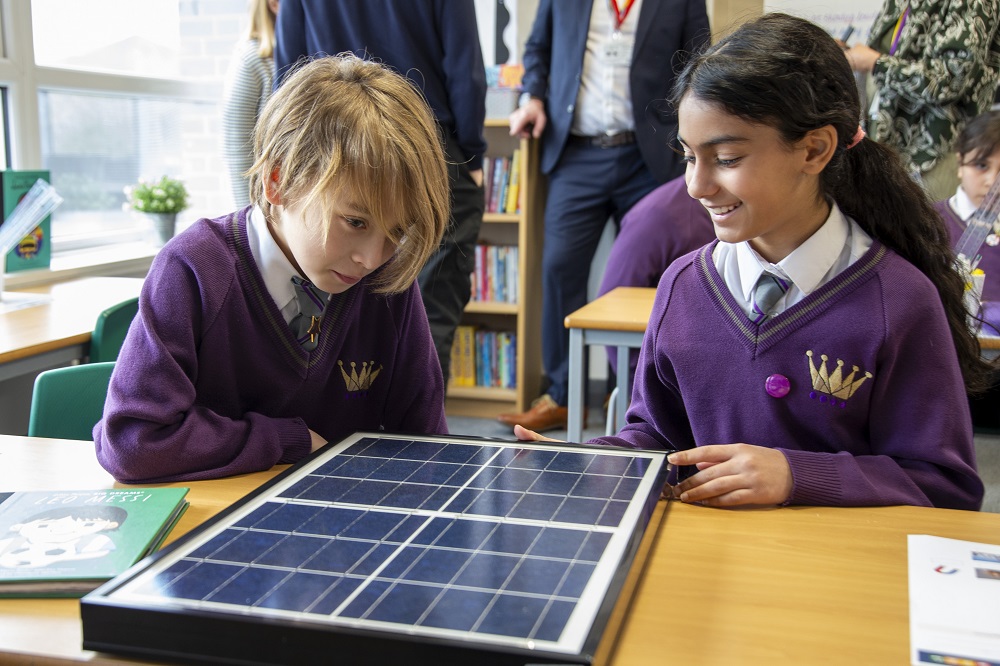Photo credit: to National Grid/ Solar for Schools
Britain’s 29,000 schools need up to £5.4 billion invested in lighting upgrades and on-roof solar power generation, if they are to achieve the government’s Net Zero targets by mid-century, new research claims.
The figure – equivalent to 5% of all government spending on education last year – comes in a report from eEnergy, a commercial provider of energy efficiency services. Its study accuses ministers of doing too little to help the nation’s primary & secondary maintained sectors meet the Net Zero goals overseen by energy ministry D-ESNZ.
“A catastrophic combination of increased impact caused by our current energy consumption, and rising operational costs for schools, has resulted in Net Zero energy infrastructure in schools being pushed down the agenda”, it charges.
The government budgeted to spend £107 billion last year on all public education, including universities, schools and colleges. The Energyst thus calculates that eEnergy’s £ 5.4 Billion estimate equates to 5% of all public spending on education.
Around 70% of UK schools are still using outdated lighting, eEnergy’s study finds. Easily switching out of fluorescent tubes & old-style thermal bulbs, then switching in LED devices, can axe bills for lighting alone by over 90%.
LEDs alone, eEnergy calculates, can save Britain’s schools as much as £2.3 Billion over ten years.
Ministers lag, still emitting more heat than light
Increasing numbers of schools now make their own energy on-site, whether via PV panels making clean electricity on roofs, or devices such as heat pumps. But eEnergy calculates asmuch as 30% of all energy generated on site is wasted, since that share is made during school holidays or at weekends.
The solution is on-site storage of clean power, the study implies, in forms such as batteries, now dropping in price.
eEnergy says its own projects in practical energy efficiency look set to yield £102.3 million net savings for clients over a ten-year period.
It has worked with 840 schools to date, installing LEDs and solar panels, advising on efficiency measures and behaviour change by users.
In one year alone, the service provider says it has helped UK schools save £13 million, the cost of 5.4 million free school meals.
Replacing hot-running, wasteful bulbs with cooler, cheaper-to-run LEDs is also a revenue earner for many of England’s 300-or so volunteer-led clean energy co-operatives. Local groups of volunteers affiliated to lobbyists Community Energy England or its Welsh & Scots equivalents, raise money in small sums from private individuals. The co-ops strike binding deals with schools & other public bodies, earning agreed revenue from savings or sales of excess generation atop classrooms.
Grant sources such as the Public Sector Decarbonisation Scheme offer cash for capital upgrades to boost efficiency. But bidders greatly outnumber donors, and schools must compete with NHS- or council-managed presmises, such as leisure centres, swimming pools and hospitals
eEnerygy’s report quotes evidence that only 21% of the £1.27 billion handed out over the last two phases of the PSDS scheme went to schools, a 20% drop in value since the first funding wave in 2020.
“Cuts in school funding since 2014 have made funding projects aiding schools’ Net Zero transition unrealistic”, it claims
“Following the latest budget announcement, 2024-2025 funding is due to be 3% lower in real terms than it was in 2010. And the lack of available capital has been compounded by soaring running costs driven by external shocks to energy markets. These have further depleted schools’ already tight budgets”.
Read eEnergy’s report here.




